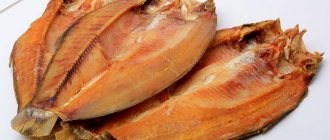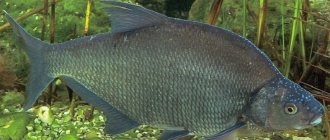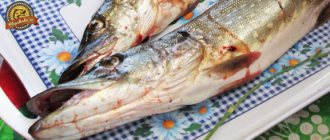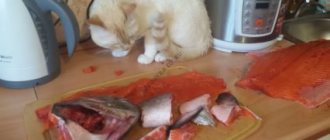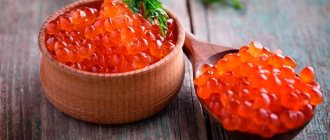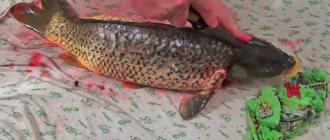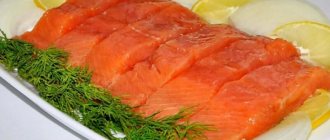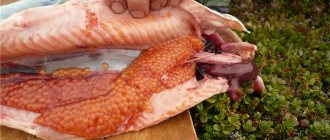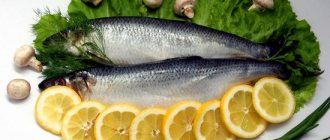Asp is a predatory fish of the carp family. It can be prepared in many ways, but most often it is salted and dried. Balyk ikh nego is an ideal snack for beer, but is also tasty on its own. Cooked in a spicy brine, it is similar to herring and goes well with boiled potatoes. If you managed to get the said fish, first of all you should find out how to salt an asp at home. Of course, you can fry or bake it, but still you should definitely try it in its salted form.
Cooking features
You can salt asp for subsequent drying or for use instead of lightly salted herring. The technology for preparing these snacks will be different. However, regardless of the chosen method of preparing this fish, the cook needs to know and take into account several important points.
- For salting, they usually use asp weighing from 1 to 3 kg, caught in the fall, since during this period it is the fattest.
- You can pickle the asp whole, in halves or cut into pieces. For balyk, it is flattened by making cuts along the ridge from the back, but leaving the belly intact. It contains the maximum amount of fat, without which the balyk turns out less tasty. However, inexperienced cooks with this method of cutting fish have difficulty cleaning it from the entrails. It’s easier for them to rip open the fish’s belly and take out the entrails through it. Then you will have to salt the asp for the balyk in halves. If you want to serve salted asp instead of herring, it is advisable to salt it with steaks or pieces of fillet.
- To salt the asp for balyk, you don’t have to remove the scales; they act as a frame. But to salt the herring, the scales need to be removed. This is done in the direction from the tail to the head with a knife or a special grater. To prevent the scales from scattering, the fish is placed in a bag.
- Before salting, the asp must not only be gutted, but also washed well, and then thoroughly dried with a napkin. It is especially important to do this if the fish will be salted dry.
- Choose coarse salt for preparing salted fish. It is important that it is not iodized, otherwise the snack will acquire an unpleasant aftertaste.
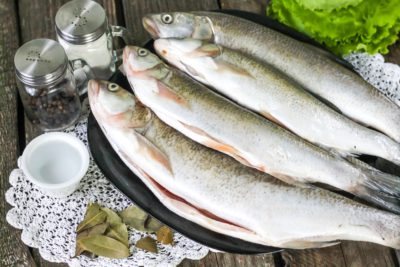
There are several recipes for salting asp. The choice depends on the purpose of salting and the gastronomic preferences of the cook. Salting time depends on the specific recipe and the size of the fish. In order to avoid mistakes and get the expected result, it is advisable to follow the recommendations that accompany the selected recipe.
Asp balyk recipe at home
Ingredients. The recipe requires very little:
- Coarse salt at the rate of 250 - 300 grams per 1 kg of fish meat.
- Spices to taste (if desired):
- 1 pinch of dry dill;
- ¼ teaspoon ground black pepper;
- 2 medium cloves of finely chopped garlic.
It is very important to control the progress of the process throughout in order to prevent flies, midges and other insects from getting on the fish: the entire prepared asp may spoil.
Preparation. The recipe goes on to describe the step-by-step procedure:
- Prepare about 1 kg of coarse table salt. One or two pieces of cotton fabric of the required size. Heavy object as oppression. Washing the fish.
- Using a sharpened steel knife, cut the fish carcass from the back from head to tail. We cut along with the rib bones, cutting right down to the abdomen so as not to lose fat. This results in a so-called “layer”. (Be careful not to damage the gallbladder, otherwise the meat will taste bitter).
- We clean the entrails and remove the gills. Wash off all residues and blood.
- Use a separate cloth to soak up the moisture from the entire surface.
- We fill the entire “layer” with a thickness of approximately 1 mm with salt and spices. Place under pressure for at least 12 – 14 hours (salting time depends on the size, thickness and weight of the fish).
- At the end of the salting process, the carcass must be soaked in water. (If the fish weighs 2 kg, the soaking time will be about 3 hours. Fish weighing about 3 kg should be soaked for less time - already an hour and a half. It is advisable to do everything under running water. If this is not possible, the volume of liquid should be no less than 5 liters. Water must be changed 4 - 5 times.
- We wrap the almost finished balyk with a prepared piece of cotton cloth soaked in a 9% vinegar solution. The recipe for asp balyk recommends hanging the fish preserved in this way out into the air in the shade, or in a draft indoors for 3 or 4 hours. The edges of the material must be connected without tears or cracks!
- Then put it in the refrigerator for a day.
- The final touch is to place the fish in the sun for 1 hour until it is covered with droplets of fat.
Salting asp for balyk in brine
Compound:
- asp – 1-1.5 kg;
- water – 1 l;
- rock salt – 100 g.
Cooking method:
- Cut the asp along the back, leaving the skin on the belly intact.
- Remove the entrails from the fish and rinse the carcass well.
- Place the asp in a container.
- Boil water in a small saucepan and add salt. Boil for 5 minutes. Allow the brine to cool to room temperature.
- Pour brine over the fish, cover with a plate, place a weight (for example, a jar of water) and put it in a cool place.
- Keep the fish in the brine for 8-12 hours. If it weighs more than the recipe calls for, increase the salting time.
To obtain balyk from an asp, it must be soaked in clean water for several hours, then wrapped in gauze soaked in vinegar to protect against insects and hung in the shade. It takes 1-2 days to dry a kilogram asp; larger specimens will also require more time.
ASTRAKHAN STYLE
This treat should be made from the following products:
- 2.5 kg asp;
- 250 g coarse salt.
Fishermen recommend using step-by-step instructions.
- Take a fish carcass weighing at least 2.5 kg and prepare it for use.
- Soak in ice water for 25 - 35 minutes and then dry.
- In areas where there is most meat, make shallow cuts.
- Rub the carcass with salt on each side and make sure that the salt gets into the cuts.
- Place the semi-finished product in an enamel container of suitable depth, place a dish on the carcass and apply pressure.
- Remove everything from the refrigerator for 12 - 15 hours.
- After the time has passed, take out the salted balyk and soak it in cold water for 45 - 60 minutes.
- After this, prepare for drying and hang in a suitable place.
Don't forget to brown the asp in the sun to give it an appetizing appearance with a golden hue.
Dry salted asp
Compound:
- asp – 3 kg;
- salt – 0.2 kg;
- sugar – 0.4 kg;
- ground black pepper – 20 g.
Cooking method:
- Cut the asp from the back, gut it, rinse, and pat dry with a paper towel.
- Combine 2 tablespoons salt and 4 tablespoons sugar. Add a teaspoon of pepper to them, stir.
- Rub the asp on all sides with the curing mixture. Wrap the fish in gauze and cloth and tie it with twine. Put it in the refrigerator.
- After a day, unwind the fish, shake off any remaining salt and sugar. Prepare a new portion of the curing mixture. Rub the asp with it. Wrap it again in cotton cloth and put it in the refrigerator.
- Renew the salting mixture every day and change the damp cloth to a dry one until the salt and sugar are gone.
- After a day, shake the fish off the curing mixture and let it dry.
Bream balyk
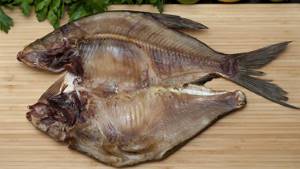
For gourmets, we suggest preparing bream balyk at home. The recipe is also simple, but requires some time.
Ingredients. To prepare we need:
- Fresh bream – 2 fish, about 2 kg each.
- Sugar – regular granulated sugar – 20 grams.
- Coarse table salt – 250 – 300 grams.
- Spices:
- ground black pepper – 30 grams;
- bay leaf – 10 leaves;
- finely ground red hot pepper – 10 grams.
- ¼ lemon.
- Finely crushed ice – 400 grams.
In addition to the products, you will also need nylon rope, gauze and a pickling container with a capacity of up to 10 liters.
Let's cook. The procedure itself will require attention and patience:
- We clean the bream from scales and wash it. Separate the head with gills, tail and fins. Carefully cut along the ridge deep to the spine. Then we cut the rib bones on one side and flatten the fish. We take out the insides no less carefully. We pay special attention to removing the gallbladder: it cannot be damaged in fish. We thoroughly rinse to remove blood and remaining entrails and remove the film.
- We cut through the meat all the way to the skin, but it is advisable not to damage the skin itself. The width of the slices is from 3.5 cm to 4 cm.
- Place the fish prepared in this way on a clean rag. (We do the same with the second copy).
- In a bowl, mix salt, sugar and all the spices. Mix everything well.
- Take a prepared container for pickling and pour the mixture into the bottom in a layer of 1 mm. Sprinkle just a little lemon juice for flavor.
- We put in the first fish. We fill it with a high-quality salt-sugar mixture. Distribute half of the bay leaves evenly, and then apply one layer of finely crushed ice. Squeeze a few drops of lemon juice to give it a harmonious taste.
- We place the second bream on top.
- We repeat the process and press down with a not very heavy - about half a kilogram - oppression.
- We put it in a fairly cold room (you can also put it in the refrigerator if it fits) with a temperature of about 0 degrees.
- After 5 days, remove the fish from the container and wash it in water to remove any remaining mixture.
- Then we put it under running water to soak and keep it like that for 3 – 4 hours. The degree of salinity can be checked by sample.
- As soon as the readiness seems satisfactory, the fish should be removed, blotted dry with a clean cloth, and proceed to the final stage.
- Take 2 pieces of capron rope, 15 cm each. At one end, the fish is grabbed by the tail with a loop, and at the other end, it is tied to the main rope and hung out. The second one is arranged in the same way.
Both balyks are wrapped in gauze to prevent damage by flies.
Spicy salted asp
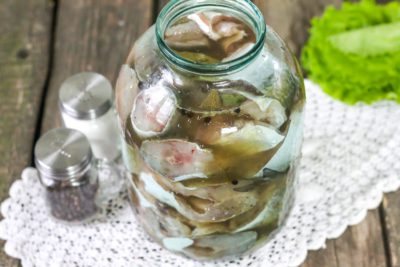
Compound:
- asp – 4.5 kg;
- water – 2 l;
- salt – 80 g;
- sugar – 20 g;
- black peppercorns – 20 pcs.;
- laurel leaves – 8 pcs.;
- cloves – 2 pcs.;
- allspice peas – 6 pcs.;
- ground coriander – 20 g.
Cooking method:
- Clean the asp from scales. Rip open the belly of the fish and remove the entrails. Cut off the heads and tails of the fish and remove the fins. Rinse and dry the carcasses. Cut them into steaks about 5 cm thick.
- Place the asp pieces tightly in a container or clean jar. They should fit into a three-liter bottle.
- Boil water, dissolve salt and sugar in it. Add bay leaves, peppercorns, cloves and coriander. Boil for 5 minutes, then cool to about 30 degrees.
- Pour brine over the fish. Close the container with a lid. Put it in the refrigerator.
After 4 days, the brine in the jar or container should be replaced with fresh brine, prepared according to the same recipe. A day after this, the fish can be served. It will taste like herring.
Preparation
1. Clean all the fish in advance, rip open the bellies of the asps, remove the entrails and thoroughly rinse along the inside of the spine - this is where all the blood collects. Combine all bulk ingredients in a deep bowl or plastic container or small bucket. If desired, you can add other dried spices: rosemary, thyme, etc.
2. Fill everything with warm water and mix. If the liquid is too hot, then cool it at room temperature, but do not pour it over the fish, otherwise it will simply cook and not be salted.
3. Cut off the heads, tails, and all fins from the carcasses: upper and lower, cut the carcasses into portions about 5 cm in length.
4. Rinse the container, place about a third of the fish mass on its bottom.
5. Pour in a third of the prepared brine so that the fish pieces are evenly distributed in it.
6. Place some of the fish back and fill it with brine again. In this way, fill the entire jar with fish slices to the top. Cover with a nylon lid and place in a cool place for 3 days. Every day, use a fork or a long knitting needle to stir the contents of the container so that the brine evenly saturates the asp pieces, drawing blood out of them. After 3-5 days, it will be necessary to create a brine again, drain the one present in the jar and fill the fish with a new one, otherwise the asp pieces will acquire an unpleasant taste, and the brine itself will become viscous and slippery due to the abundant blood content.
7. Before serving, the fish appetizer should be removed from the jar and placed on a dish or in bowls; there is no need to rinse the fish! You can supplement it with onion slices.
Comment No votes yet.
Please wait…
How to fry properly
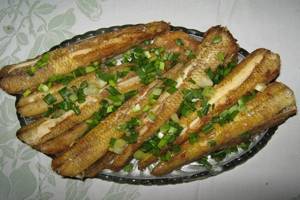
The easiest way to cook asp is to fry it in a frying pan with oil. It turns out very tasty and also quick. The recipe requires a minimum of ingredients, but you can add others.
- medium asp carcass;
- tsp salt;
- ½ lemon;
- spices;
- vegetable oil for frying.
Remove scales from the fish, gut the insides, and rinse with water. Remove the gills to prevent the meat from becoming bitter, or cut off the head altogether. Make shallow cuts crosswise on the sides with a knife, they are needed so that the meat is fried more evenly.
Blot the carcass with dry napkins to remove excess moisture, rub the outside and inside with salt and spices; cumin, rosemary, coriander, thyme, and ground black pepper work well. Squeeze lemon juice to neutralize fishy odor while cooking.
How to serve and eat lightly salted herring

As a rule, lightly salted herring is served with seasonings and also sprinkled with sunflower oil. Fried or boiled potatoes, as well as mashed potatoes, go well with herring. This is a wonderful, tasty dish that can decorate a holiday table. Naturally, the most delicious herring is considered to be the one prepared with your own hands.
In addition, lightly salted herring can serve as the basis for preparing various dishes, such as “Shuba” or “Herring under a fur coat.” A very tasty dish, but it requires special ingredients, the main thing is that there is herring. This dish successfully decorates the holiday table, including New Year's. It just so happened that the “Olivier” salad and “Herring under a fur coat” are the main dishes on the table for the New Year. But this is only a small part of the delicious dishes that can be prepared using lightly salted herring.
Using similar recipes, as well as salting techniques, you can salt other types of fish that are found in our reservoirs. Silver carp prepared according to such recipes can turn out to be much tastier than herring.
Recipe for herring fillet with lemon
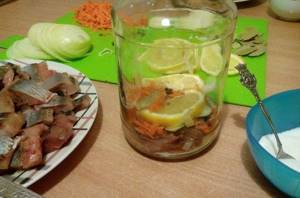
Take two large herring fish with the addition of the following ingredients:
- 2 tbsp salt and 1 tbsp sugar;
- 5 pcs bay leaves;
- 12 pcs allspice;
- 2 lemons.
The herring is cleaned and cut into separate fragments. Pieces of herring are laid out in layers in a specially prepared container. Each layer is diluted with lemon, salt, sugar and spices. After this, the fish prepared in this way is pressed down with a plate with a weight and sent to the refrigerator for three days, no more.
Quick salting asp
- asp – 1.5 kg;
- water – 1 l;
- apple cider vinegar (6 percent) – 20 ml;
- salt – 40 g;
- sugar – 20 g;
- laurel leaves, pepper, mustard seeds - to taste.
- Clean the asp. Rip open the belly of the fish and remove the entrails. Trim the meat from the spinal bone. Cut the fillet into slices 2-3 cm thick. Place in a liter jar or container.
- Boil water, pour salt, sugar into it, add spices, focusing on your taste.
- Boil the brine for 10 minutes. Pour vinegar into it and stir. Remove from heat immediately.
- Allow the mixture to cool to 35-40 degrees, pour it over the asp pieces.
- After an hour, put the container with the asp in the refrigerator, having closed it first.
After 12 hours, the asp, salted according to this recipe, will be ready for consumption. It tastes like preserves. If you double the amount of vinegar and leave the asp to salt for 24 hours, the bones in it will soften, making it much more pleasant to eat.
When serving salted asp, it doesn’t hurt to sprinkle with chopped onions, pour over vegetable oil, and garnish with sprigs of herbs or lemon slices.
